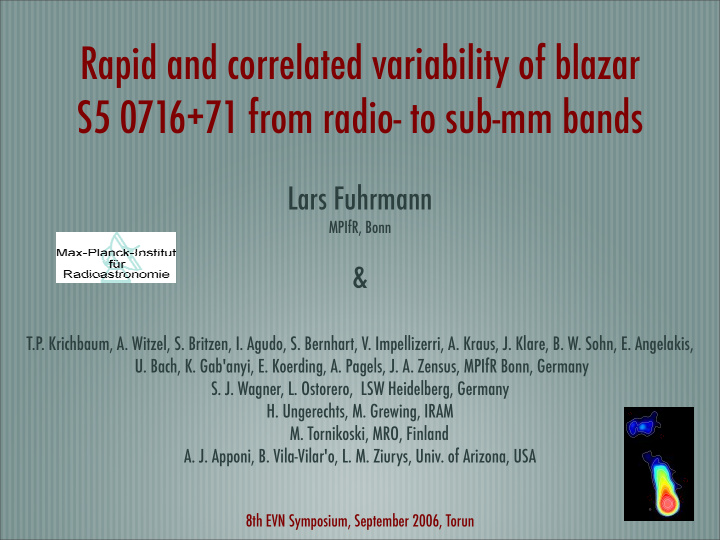



Rapid and correlated variability of blazar S5 0716+71 from radio- to sub-mm bands Lars Fuhrmann MPIfR, Bonn & T.P. Krichbaum, A. Witzel, S. Britzen, I. Agudo, S. Bernhart, V. Impellizerri, A. Kraus, J. Klare, B. W. Sohn, E. Angelakis, U. Bach, K. Gab'anyi, E. Koerding, A. Pagels, J. A. Zensus, MPIfR Bonn, Germany S. J. Wagner, L. Ostorero, LSW Heidelberg, Germany H. Ungerechts, M. Grewing, IRAM M. Tornikoski, MRO, Finland A. J. Apponi, B. Vila-Vilar'o, L. M. Ziurys, Univ. of Arizona, USA 8th EVN Symposium, September 2006, Torun
Content Overview Results I Data analysis Results II Conclusions L. Fuhrmann, 8th EVN Symposium, September 2006, Torun
Overview intrinsic radio IDV: inverse Compton (IC) limit might actually be violated, then outbursts of IC scattered radiation at X-/ γ -ray bands (e.g. Slysh 1992, Bloom & Marscher 1996) S5 0716+71: z > 0.3 allows only to derive lower limits to lin. size, T B , δ VLBI: kinematic study revealed atypically high apparent speeds of 4.5 --16c and (Bach et al. 2005) Bach et al. 2005
Overview coordinated & global multi-frequency campaign - core centered around a 500 ksec Integral pointing during Nov. 10 - 17, 2003 (Ostorero et al. 2006) Aim: search for multi-frequency signatures of IC flashes search for rapid & correlated (intra- to inter-day) variability in the cm- to sub- mm bands and signatures of an IC catastrophe simult. constrains on variability T B and δ in comparison with high energy emission Radio telescope & Institute Location λ obs [mm] . WSRT (14x25 m), ASTRON Westerbork, NL 210, 180 radio telescopes: E ff elsberg (100 m), MPIfR E ff elsberg, D 60, 28, 9 Pico Veleta (30 m), IRAM Granada, E 3.5, 1.3 Mets¨ ahovi (14 m), MRO Mets¨ ahovi, Finland 8 Kitt Peak (12 m), ARO Kitt Peak, AZ, USA 3 SMTO / HHT (10 m), ARO Mt. Graham, AZ, USA 0.87 JCMT (15 m), JAC Mauna Kea, HI, USA 0.85, 0.45
S5 0716+71 - results I light curves in the cm regime 2.8 cm 6 cm
S5 0716+71 - results I light curves in the mm regime 3 mm 9 mm Agudo et al. 2006
S5 0716+71 - data analysis Summary: “unusual” monotonic increase in total flux density with variability amplitudes systematically increasing towards higher frequencies combined analysis of all data sets: time series analysis (SF, ACF, p2p) reveals var. T B ‘s and Doppler factors cross-correlation analysis (CCF) spectral evolution study long-term variability and broad band characteristics
S5 0716+71 - results II SF & ACF & p2p analysis: t var > ~ 4 days T B (type I,cm) > to T B (type I,mm) > to thus, IC limit always violated ! Doppler factors: using the IC limit of (Kellermann & Pauliny-Toth 1969) using the equipartition value of (Readhead 1994)
S5 0716+71 - results II CCF analysis: variability pattern strongly correlated with systematic trend of increasing time lag towards larger frequency separation flux density increase first at higher frequencies m more pronounced towards higher ν ‘canonical’ behavior: synchrotron cooling & adiab. expansion (e.g. van der Laan 1966, Marscher & Gear 1985) intrinsic !
S5 0716+71 - results II m vs. ν : comparison with weak scintillation thin screen slab model for weak quenched scattering (Beckert et al. 2002) strong discrepancy between model calculations and observations no strong ISS contribution !
S5 0716+71 results spectral analysis: to Doppler factors from synchrotron & equipartition magnetic field: > 12 -- 23
Conclusions INTEGRAL: no IC catastrophe - only upper limits for soft γ -ray emission IC Doppler factors “unusual” variability behavior in November 2003 intrinsic variations internally consistent lower limits for δ (and ) no IC catastrophe by INTEGRAL & no scintillation violation only apparent & intrinsic Doppler boosting can naturally explain the non-detection at higher energies
1.3 mm S5 0716+71 - results I towards higher frequencies... Agudo et al. 2006
Recommend
More recommend